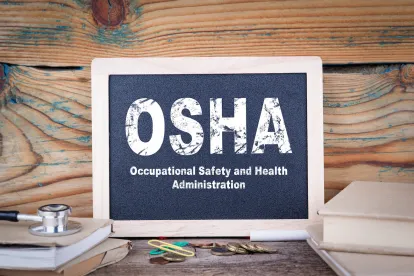On July 7, 2020, the federal Occupational Safety and Health Administration (OSHA) issued COVID-19 control and prevention guidance for oil and gas industry workers and employers. The guidance supplements OSHA’s interim guidance for the general workforce.
Oil and Gas Workers Are at Medium to Low Risk of Exposure to COVID-19
One of OSHA’s benchmarks for protecting employees from COVID-19 requires employers to assess their workplaces and determine whether job tasks place their employees at one of four levels of risk exposure: very high, high, medium, and lower risk. The agency recommends that employers conduct a hazard assessment to identify whether and how often workers may be in close contact (i.e., within six feet) to coworkers, supervisors, or other individuals at the job site.
The good news for the oil and gas industry is that OSHA does not anticipate a very high or high risk of exposure. According to the guidance, “[m]ost oil and gas drilling, servicing, production, distribution, and/or processing tasks are associated with lower or medium exposure risks.” Examples of oil and gas work activities with a medium or lower risk include the following:
Medium-Risk Activities
- “Oil and gas drilling, servicing, production, distribution, and/or processing tasks that require frequent close contact (within 6 feet) with coworkers, contractors, customers, or the general public.
- Work in “frequent high-traffic areas,” such as control rooms, trailers, and doghouses.
- “Traveling within facilities or between facilities when workers must share vehicles.”
Low-Risk Activities
- “Oil and gas drilling, servicing, production, distribution, and/or processing tasks that do not require frequent close contact with other coworkers, contractors, customers, or the public.”
- “Performing duties in non-public areas of oil and gas production and/or processing facilities, away from other workers or the public.”
Use Cloth Face Coverings
Regardless of the exposure risk level, OSHA advocates that all workers in the oil and gas industry wear cloth face coverings. The agency also recommends that workers wear face coverings “in common areas such as the drill deck, doghouse, control rooms, and office spaces in the trailers.”
Controls to Mitigate Medium Risk Activities at the Worksite
OSHA emphasizes social distancing as the primary method of mitigating worker exposure to COVID-19. This includes a recommendation to “[c]onfigure communal work environments (such as control rooms, jobsite trailers and/or doghouses) so that workers are spaced at least six feet apart, if possible.” If the nature of work makes social distancing infeasible, then the use of physical barriers between workers (such as strip curtains, plexiglass, or other impermeable dividers or partitions) are acceptable, so long as the barrier “does not create additional safety hazards (e.g., reduced visibility in/around work vehicles or other equipment).”
OSHA recommends that employers pay special attention to pedestal or hard-mounted fans to ensure they do not blow air directly from one employee to another. The agency also suggests that personal cooling fans be removed from the worksite to help reduce the spread of COVID-19.
Other suggestions from OSHA include the following:
- Stagger shifts and break times, when possible, “to avoid congregations of workers in parking areas, locker and shower rooms, smoking areas, control rooms and other common areas.”
- “Encourage … single-file movement with six feet between each worker through the facility/site, where possible.”
- Utilize floor markings or signs (such as those used by supermarkets) to remind employees to maintain social distancing
- “Designate workers to monitor and facilitate distancing.”
- “Limit the number of personnel allowed in doghouses, control rooms, and other operating areas.”
- “Limit meeting sizes and/or hold meetings virtually or using social distancing outside, if possible.”
- “Remove or rearrange chairs and tables, or add partitions to tables, in break rooms, control rooms, and other areas workers may frequent to increase worker separation.”
- “Identify alternative areas to accommodate overflow volume, such as training and conference rooms, or using outside tents for shaded break and lunch areas.”
Carpooling or Use of Company Vehicles
Under the guidance, employers should “[e]ncourage workers to avoid carpooling to and from work and job sites, when possible. However, this can be a challenge due to the nature of the oilfield industry, which often requires employees to travel to worksites far away from their homes. For example, traveling to a worksite 100 miles from a local yard is not uncommon for oilfield work in West Texas. Recognizing this reality, OSHA recommends the vehicle’s windows remain open to circulate air. The agency also suggests the following:
- Wear cloth face coverings.
- “Limit the number of people per vehicle as much as possible.”
- “Encourage cohorting (grouping together) of workers to keep exposure groups as small as possible.”
- “[M]aintain social distancing as much as possible.”
“[P]ractice proper hand hygiene, such as hand washing or, if soap and water are not readily available, use hand sanitizer that contains at least 60% alcohol, before entering the vehicle and when arriving at the destination.”
- “Clean and disinfect commonly touched surfaces after each carpool or shuttle trip (e.g., door handles, handrails, [and] seatbelt buckles).”
- “Encourage workers to follow coughing and sneezing etiquette when in the vehicle.”
Takeaways
- Although the OSHA guidance did not mention the importance of daily COVID-19 prescreening efforts such as questionnaires and temperature checks, oil and gas employers may want to adopt these control methods.
- Employers may want to ensure that daily cleaning includes regular disinfectant cleaning of oilfield equipment (such as tongs) and tools.
- OSHA’s recommendations mean that oil and gas employers may need to intensify their heat illness prevention efforts this summer. The removal of personal fans and use of face coverings increases the heat load on employees. Among other things, oilfield employers may want to consider increasing the frequency of water breaks and bringing extra water to the worksite. In addition, employers may want to discontinue the use of common water dispensers, such as iced-down five-gallon coolers, and replace them with bottled water.
- Rolling down the windows on the crew truck when driving to a location may not be a bad idea when temperatures cool down later this year, but for now employers may want to take into consideration the heat and often-dusty conditions in places like West Texas, where the heat index can soar above 110 degrees Fahrenheit. Most crews would presumably opt to keep the air conditioning on, and wear face coverings in the crew truck.
- Partitions on the work floor may pose issues for employers. Crews and oilfield equipment (tongs, for example) frequently move around the work floor. Given the nature of the work, plexiglass partitions likely cannot be bolted into fixed positions on the work floor and could present a hazard. Strip curtains are an interesting idea, seemingly borrowed from OSHA’s meatpacking guidance. But where do employers hang them on a drilling or well servicing rig?
- Oil and gas employers can focus their prevention efforts on universal precautions, such as promoting hand washing, practicing social distancing as much as possible, and when social distancing is not feasible, requiring the use of face coverings (subject to exceptions).





 />i
/>i
